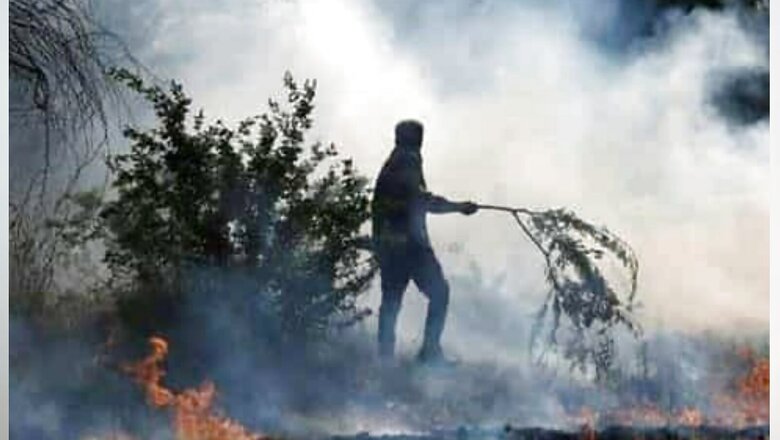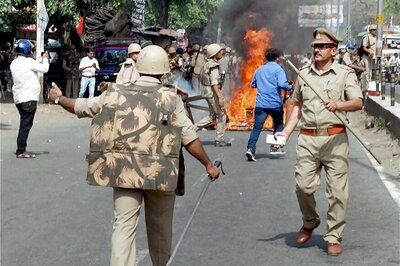
views
Delhi usually experiences two spells of severe air pollution during winters. One in October-November and the other in December-January. The first spell of pollution is associated with Diwali firecrackers and stubble burning. But this year is proving different.
The week starting September 19 saw Delhi suddenly choking from toxic air, well ahead of Diwali and the onset of stubble burning season in neighbouring Punjab, Haryana, and Uttar Pradesh. The air quality in Delhi deteriorated sharply, turning hazy and toxic barely three days after the city witnessed its first odd ‘good air quality day’ of the year.
According to Central Pollution Control Board (CPCB) data, the average Air Quality Index (AQI) of Delhi on September 19 at 4 pm slipped to 182 from 119, 70 and 47 the previous three days. The most polluted areas were Anand Vihar in ‘severe’ category’ AQI of 405. There was no respite on the next day either when Anand Vihar’s AQI worsened to 418 and that of Shadipur to 213 and average Delhi AQI stayed above 160.
Make no mistake, even with India’s lax AQI standards, an AQI of more than 100 is bad news for Delhi and beyond 200 is crisis. Above 400 is outright killer.
WHAT AQI LEVEL IS SAFE?
As per India’s Air Quality Index, an AQI of ‘0’ to ‘50’ is termed ‘good’; 51 to 100 is ‘acceptable’. Thereafter begin non-acceptable AQI levels — ‘101 to 200’ is ‘moderate’, 201 to 300 is ‘poor’, 301 to 400 ‘extremely poor’, 401 to 500 is ‘severe’ and beyond 500 is ‘severe-plus emergency’.
India’s air pollution standards were introduced in 2015 and NAAQ last revised it in 2009. These are substantially lax not only compared to WHO’s latest revised 2021 standards, but even when compared to WHO’s 2005 standards.
WHY POLLUTION MATTERS?
The CPCB, in its report for air pollution for 2019, says that on an average, a person inhales around 14,000 litres of air daily. Also, on average, a person breathes 25,000 times a day.
For Delhi residents, this means inhaling 14,000 litres of toxic air a day. These are toxins which once deposited in lungs cannot be cleansed. Worse, continued inhalation of toxic gases affects all organs of the body and not just the lungs.
Poor air quality affects the quality of life now and for future generations by affecting health, environment, economy, and the city’s liveability.
Polluted air has wide ranging adverse health implications, from simple skin and eye irritation to severe neurological, cardiovascular, and respiratory diseases, asthma, chronic obstructive pulmonary disease (COPD), bronchitis, lung capacity loss, emphysema, lungs cancer and even diabetes.
Maternal exposure to ambient air pollution is associated with adverse birth outcomes, such as low birth weight, pre-term birth and small gestational age births.
HOW BAD IS DELHI POLLUTION?
A peer-reviewed study in Lancet reported in 2020 that Delhi suffered highest per capita economic loss in the country the previous year and that, in the national capital, the loss due to the lost output from premature deaths and illness attributable to air pollution as a percentage of state GDP was 1.06%.
According to the study, the economic loss per capita was the highest in Delhi, to the tune of $62 followed by neighbouring Haryana at $53.8. The study also revealed that in 2019, 1.67 million deaths were attributable to air pollution, accounting for 17.8% of the total deaths in the country.
The most damning finding of the study was that out of the total economic loss of $36.8 billion attributable to air pollution in India in 2019, 36.6% was from lung diseases, which included COPD (21.1%), lower respiratory infections (14.2%), and lung cancer (1.2%), and the rest was from ischaemic heart disease (24.9%), stroke (14.1%), diabetes (8.4%), neonatal disorders (13.3%), and cataract (2.7%).
A Greenpeace study released in September 2021 found that in Delhi, city-wide annual average air pollution levels exceeded the 2005 WHO guidelines by nearly eightfold in 2020, the highest margin of all cities in Greenpeace dataset. The study also estimated 57,000 premature deaths in Delhi during 2020 attributable to air pollution alone.
DELHI AIR IS PERPETUALLY TOXIC
To put Delhi’s pollution in context, as per AQI 2022 report, Delhi, for the fourth consecutive year, was adjudged world’s most polluted capital. In 2021, its PM 2.5 (96.4 μg per-cum) was 14.6% more than in 2020. It is not surprising because in tandem with Delhi, 35 Indian cities are in top 50 globally most polluted cities and 64 are in the world’s worst 100.
A more recent report by US-based Health Effects Institute released in August, 2022 using data from 2010 to 2019 after analysing incidence of pollution of more than 7,000 cities globally, focusing on two of the most harmful pollutants — fine particulate matter (PM2.5) and nitrogen dioxide (NO 2) — found that Delhi is the worst globally with regard to dangerous PM 2.5 particulate pollution with an average annual PM2.5 exposure (relative to population) of 110 µg/m3.
Contrarily in 2005, Delhi, after retrofitting its entire bus fleet to CNG, was lauded by the World Bank and WHO as the poster-boy of global pollution reduction. The new poster-boy in 2022 is Beijing, which was the pollution capital of the world in 2005. With massive push towards non-polluting public transport, Beijing is no longer among top 20 most polluted cities in the world and with the passage of every year it is reducing its air pollution footprint.
And make no mistake, this September pollution level is not accidental.
As per Government of India data presented in Rajya Sabha on July 27, 2022, in Delhi there was not even one ‘Good Air Quality’ day in the six months of the year and barely seven “satisfactory” and 47 “moderate” air quality days were witnessed during this period, whereas Delhi witnessed 105 poor, 21 very poor and one severe air quality days.
WHAT ARE THE DIFFERENT TYPES OF POLLUTANTS?
There are many sources of air pollution that have adverse impacts on health, but as per WHO, pollutants with the strongest evidence for public health concern include particulate matter (PM2.5 and PM10), carbon monoxide (CO), ozone (O3), nitrogen dioxide (NO2) and sulphur dioxide (SO2).
WHO further says that the fine particulate matter is an especially critical source of health risks, as these very small particles can penetrate deep into the lungs, enter the bloodstream, and travel to organs causing systemic damages to tissues and cells.
WHY DELHI AIR POLLUTION IS SO MUCH WORSE?
Every time Delhi’s air pollution worsens, there is a readymade knee-jerk explanation – “the latest September pollution is attributed to calm winds with high humidity in the Delhi-NCR in the night of September 17 and 18”.
Important to note here is that the recent worsening of pollution is completely attributable to local emission sources as Delhi’s neighbouring states are yet to begin their crop stubble burning after paddy season.
There are many reasons for Delhi’s pollution worsening over the years.
One, air pollution indeed is a complex cross-sectional problem with varied emission sources contributing to the chaos. Two, Delhi air pollution is partly nature-ordained, partly of its own follies and partly the contribution of its neighbours.
The geographical and meteorological factors make Delhi vulnerable to lethal and silent air pollution. Delhi’s 1.33 crore private vehicles are its own follies. And it is worsened by the ritual of stubble burning by farmers of neighbouring states even though it was officially banned in 2015.
Three, air pollution is also the by-product of faster GDP growth and rising prosperity of the nation’s capital.
Four, a key causative factor at the root of Delhi’s air pollution are private vehicles older than 15 years.
Five, other contributors to fast growing pollution are industry, construction, waste burning, energy, residential sources, and road dust.
A study by the Centre of Science and Environment (CSE) on November 11, 2021, came up with damning findings. It said the key pollution sources include transport, industry, construction, waste burning, energy, residential sources, road dust and others. In 2021, vehicles emerged as the biggest contributor to particulate pollution in Delhi – their real-time share increased to more than 50 per cent during the early phase of winter (October 24-November 8, 2021).
After vehicles, other major pollution sources are household pollution (12.5-13.5 per cent), industry (9.9-13.7 per cent), construction (6.7-7.9 per cent), waste burning and road dust (each varied between 4.6-4.9 per cent and 3.6-4.1 per cent, respectively).
WHAT IS THE GOVERNMENT DOING?
In 1980, India did not measure pollution. It had no monitoring station. Even in 1984, as per CPCB dataset, the country had just seven monitoring stations, which increased to 260 in 1992, 523 in 2011, 680 in 2016 and 804 in 2019. Out of these, 32 monitoring stations are in Delhi, so technically Delhi should at least know the extent of its air pollution problem.
Delhi is the epitome of the prevalent Indian paradigm: best way to combat air pollution is blissful ignorance till the entire city is choked during four months of winter when severe AQI above 400 or even exceeding unpardonable 500 becomes the norm.
When the worst comes in winter months, the only solution so far which the government has devised is the reactive Graded Response Action Plan (GRAP).
GRAP, instead of trying to systemically reduce pollution by tackling industrial, vehicular and combustion emissions, is an emergency plan to stop activities when Delhi air quality worsens.
Under GRAP, activities are stopped when Delhi air quality deteriorates as per four different stages: Stage I – ‘Poor’ (AQI 201-300); Stage II – ‘Very Poor’ (AQI 301-400); Stage III – ‘Severe’ (AQI 401-450); and Stage IV – ‘Severe Plus’ (AQI >450). GRAP is a total failure as can be seen in fast-worsening pollution in Delhi and NCR.
The real problem is state denial and inaction. Findings of domestic and global think-tanks and their reports are routinely debunked, citing bias, disconnect with Indian conditions and unreliable causality link between air pollution, health, and mortality.
As per a September 8, 2022 report, after decades of denial and apathy, the Delhi government has woken up to find out what relative contribution of various pollutants results in massive pollution load on the city. The study, however, is supposed to be using machinery imported from the US and artificial intelligence in collaboration with IIT-Kanpur, IIT-Delhi and The Energy and Resources Institute (TERI).
All it costs is Rs 12 crore. Why could this not have been pursued decades ago?
THE SOLUTION
Delhi clearly needs visionary strategic planning and evidence-based solutions to cut off pollution from where it originates in a time-bound manner. Delhi has to wake up to the need of making polluters pay the real cost of polluting, like Singapore and Beijing.
The causes of Delhi’s pollution are well-known and documented. Evidence-based solutions exist. It is time for the city to get its act together.
Let the solution begin with the city’s transport — complete elimination of fossil fuel-guzzling vehicles by 2030. Let the path to India Net Zero by 2070 begin with the national capital.
The beginning should be 10,000 electric buses plying in Delhi by 2025. Delhi also needs urgent fast-tracking of its Metro rail from 400 km today to 600 km by 2025 and 1,000 km by 2030.
Last but not the least, make polluters pay.
Akhileshwar Sahay is noted infrastructure expert with special interest in problems Indian cities face. He is President Advisory Services of the consulting company BARSYL. The views expressed in this article are those of the author and do not represent the stand of this publication.
Read all the Latest Opinion News and Breaking News here


















Comments
0 comment